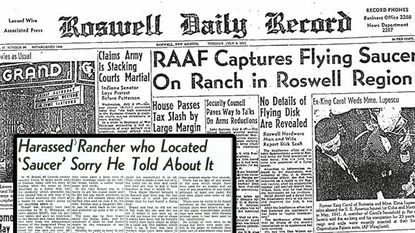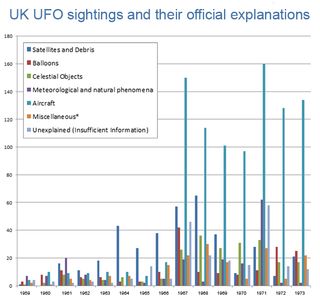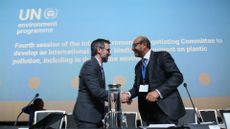The Roswell incident: how ‘UFO sighting’ sparked 70 years of conspiracy theories
A US government ‘cover-up’, the declassification of top secret files and big-budget alien movies have fuelled interest in UFOs

On 8 July 1947 the Roswell Daily Record newspaper published a front page article with the headline “RAAF Captures Flying Saucer On Ranch in Roswell Region”, and the legend of America's most famous brush with aliens was born.
Today, many conspiracy theorists consider the so-called “Roswell incident” to be one of the most conspicuous pieces of evidence that the US government has covered up the existence of extraterrestrial life on Earth.
Next month thousands of people from all over the world will travel to the town, the de facto UFO capital of the world, but the Roswell story's position in the public imagination was far from immediate.
Subscribe to The Week
Escape your echo chamber. Get the facts behind the news, plus analysis from multiple perspectives.

Sign up for The Week's Free Newsletters
From our morning news briefing to a weekly Good News Newsletter, get the best of The Week delivered directly to your inbox.
From our morning news briefing to a weekly Good News Newsletter, get the best of The Week delivered directly to your inbox.
What was the Roswell incident?
On 7 July 1947, around 75 miles north of the town of Roswell in New Mexico, debris from a highly classified project used by the US Army Air Force (the precursor to the US Air Force) to detect atomic bomb tests in the Soviet Union, was recovered from a ranch after being reported by ranch worker William Brazel.
Intrigued by the idea of flying saucers, Brazel gathered some of the debris and went to Roswell where he told Sheriff George Wilcox about his find. According to reports he “whispered kinda confidential like”. Wilcox immediately reported the encounter to the USAAF base at Roswell which promptly sent agents to visit the ranch, but not before the press picked up the story.
What was reported at the time?
On 8 July 1947 Roswell Army Air Field (RAAF) issued a press release stating that a “flying disk” had crashed on a ranch near Roswell during a powerful storm. Later in the day, as government scientists arrived in the area, the story appeared to change. A press conference was held and it was stated instead that a weather balloon had crashed. Reporters were shown debris said to be taken from the crash area, such as foil, rubber and wood, which appeared to confirm that the object had been a weather balloon.
After initially suggesting that Brazel's debris had come from a UFO, the Roswell Daily Record reported a correction which included the USAAF statement that it was a weather balloon that had been found at the site. Brazel later went on record to say that he regretted the publicity that his misidentification had caused.
According to the official accounts, the debris Brazel found came from a balloon which was part of an experimental technology trial codenamed Project Mogul.
What was Project Mogul?
The classified Project Mogul was designed to detect sound waves in the upper atmosphere from Soviet atom bomb tests by flying microphones on trains of balloons at high altitude. Although the technology was quickly superseded, it remained secret for more than 20 years after the event. The fact that the balloon was involved in Cold War surveillance of the Soviet Union may have helped to propel rumours of a cover-up.
How did it become a cause celebre?
For 31 years the story was largely forgotten until The National Enquirer reported the original Roswell Daily Record story again, but not the correction. Following the publication of the new story, theories suggesting that the government's incomplete account had been an attempt to cover-up the discovery of an alien spacecraft began to take root.
What did other witnesses say?
Several people claimed to have seen debris scattered over a wide area and at least one person reported seeing a blazing aircraft in the sky shortly before it crashed, but the key account came from a former mortician, Glenn Dennis, who claimed in 1989 that a friend who worked as a nurse at the Roswell Army Air Field had accidentally walked into an examination room where doctors were bent over the bodies of three creatures. They apparently resembled humans, but with small bodies, spindly arms and giant bald heads.
In 1995, Ray Santilli, a London-based entrepreneur, released “footage” of an alien autopsy performed in Roswell in 1947. Experts immediately ridiculed the footage as a hoax and he admitted years later that it was almost entirely fake. Nevertheless, Santilli insisted real footage existed, but due to its poor condition he had been forced to recreate it.
Critics have questioned the validity of various witnesses and pointed out that many claims over the years have come from “friends of friends” who supposedly saw something out of the ordinary.
Stranger than fiction?
Coincidentally, the republication of the story came just one year after the release of Close Encounters of the Third Kind, a film about a government conspiracy covering up alien visits to Earth. The film was released in the USA in November and the following year in the UK. That year 750 sightings were officially documented in the UK by the Ministry of Defence UFO desk, the highest figure on record.
Did UFO sightings continue to increase?
Looking at UFO sightings data from both sides of the Atlantic, a direct correlation between popular films involving aliens and real world UFO sightings becomes evident. In 2009, The Guardian detailed the popular culture influences that may have helped propel UFO sightings in the UK in 1996. In the year that Independence Day and Mars Attacks were released there were 609 UFO sightings across the UK, significantly more than the years just before or after.

The MoD assembled detailed records of UK UFO sightings between 1959 and 1973 before cuts ended the program
Unofficial data, supplied by the National UFO Reporting Centre in America suggest that UFO sightings have been slowly increasing in the US since the 1970s, growing increasingly rapidly since the early 1990s.
One possible explanation for this is that the reporting centre became both better known and easier to contact with the advent of new technologies such as fax machines and the internet.
In 2014, The Economist analysed the available data from 2000 to 2014 and found that most UFOs were reported when people were drunk.
Did declassifying Project Mogul help?
Even though Project Mogul was declassified in the 1970s, it wasn't fully connected to Roswell until 1994 when the normally secretive National Security Agency finally published an in-depth report refuting all claims of a conspiracy at the site. A second report, released in 1997, concluded that reports of alien bodies actually related to life-sized anthropomorphic test dummies.
But by providing detailed analysis of the Roswell incident, many analysts believe that the US government inadvertently fuelled interest in conspiracy theories and public suspicions that the US military was involved in a cover-up.
Roswell: the UFO capital of the world
Because of the huge notoriety surrounding the Roswell incident, the town has become Ground Zero for UFO conspiracists.
Each year on the anniversary of the story, thousands of enthusiasts embrace all things alien and paranormal at a UFO Festival. There, they can dissect mock alien bodies and take part in scientific experiments.
Last year, to mark 70 years since the incident was first reported, around 38,000 people turned up from all over the world.
Kathy Lay, executive director for MainStreet Roswell, says:
“You have people all over the city. There will be some out at the mall at Galactic Con. Some will be at the UFO museum doing the seminars and workshops. You'll have some that will be going to the plays that are going on, some will be over at the planetarium, some will be here at this festival. They're all over - we just embrace it.”
Create an account with the same email registered to your subscription to unlock access.
Sign up for Today's Best Articles in your inbox
A free daily email with the biggest news stories of the day – and the best features from TheWeek.com
-
 Ottawa climate talks: can global plastic problem be solved?
Ottawa climate talks: can global plastic problem be solved?In the spotlight Nations aim to draft world's first treaty on plastic pollution, but resistance from oil- and gas-producing countries could limit scope
By Harriet Marsden, The Week UK Published
-
 Netherlands split on WFH for sex workers
Netherlands split on WFH for sex workersSpeed Read Councils concerned over 'nuisance' of at-home sex work, but others say changes will curb underground sex trade
By Arion McNicoll, The Week UK Published
-
 'He adored Trump, and then rejected him'
'He adored Trump, and then rejected him'Today's Newspapers A roundup of the headlines from the US front pages
By The Week Staff Published
-
 Puffed rice and yoga: inside the collapsed tunnel where Indian workers await rescue
Puffed rice and yoga: inside the collapsed tunnel where Indian workers await rescueSpeed Read Workers trapped in collapsed tunnel are suffering from dysentery and anxiety over their rescue
By Sorcha Bradley, The Week UK Published
-
 Gaza hospital blast: What the video evidence shows about who's to blame
Gaza hospital blast: What the video evidence shows about who's to blameSpeed Read Nobody wants to take responsibility for the deadly explosion in the courtyard of Gaza's al-Ahli Hospital. Roll the tape.
By Peter Weber, The Week US Published
-
 Giraffe poo seized after woman wanted to use it to make a necklace
Giraffe poo seized after woman wanted to use it to make a necklaceTall Tales And other stories from the stranger side of life
By Chas Newkey-Burden, The Week UK Published
-
 Helicopter sound arouses crocodiles
Helicopter sound arouses crocodilesTall Tales And other stories from the stranger side of life
By Chas Newkey-Burden, The Week UK Published
-
 Woman sues Disney over 'injurious wedgie'
Woman sues Disney over 'injurious wedgie'Tall Tales And other stories from the stranger side of life
By Chas Newkey-Burden, The Week UK Published
-
 Emotional support alligator turned away from baseball stadium
Emotional support alligator turned away from baseball stadiumTall Tales And other stories from the stranger side of life
By Chas Newkey-Burden, The Week UK Published
-
 Europe's oldest shoes found in Spanish caves
Europe's oldest shoes found in Spanish cavesTall Tales And other stories from the stranger side of life
By Chas Newkey-Burden, The Week UK Published
-
 Artworks stolen by Nazis returned to heirs of cabaret performer
Artworks stolen by Nazis returned to heirs of cabaret performerIt wasn't all bad Good news stories from the past seven days
By The Week Staff Published